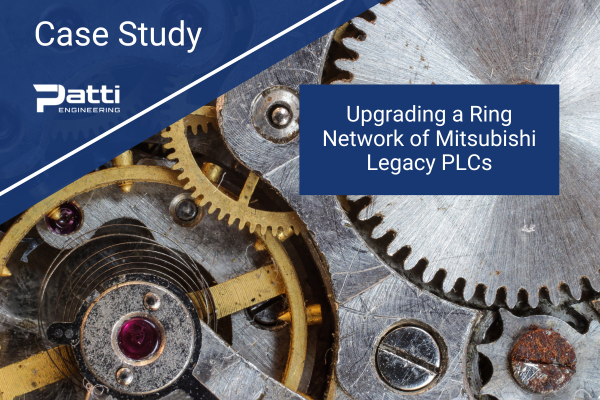
Upgrading a Ring Network of Mitsubishi Legacy PLCs
Patti Engineering is nearing completion of a multi-stage legacy controls upgrade project on behalf of a steel industry client. A ring network of older Mitsubishi A-series PLCs have been upgraded with Q-series counterparts, restoring full network connectivity and reducing further risk associated with legacy controls.
Project Description
When a network of legacy PLCs failed to report product masses to their database, A major steel company reached out to Patti Engineering to upgrade the older legacy A-series Mitsubishi PLCs to their modern Q-series counterpart at the company’s Ecorse, Michigan facility. Patti Engineering has an extensive background and skillset portfolio of controls upgrades. As is often the case, once the upgrade process for the first PLC was underway, further unforeseen complications were revealed in regards to data collection as well as the integrity of the connecting fiberoptic cables. The PLCs were organized in a ring network, with a designed master PLC holding responsibility for collecting data from the others. Patti Engineering successfully completed the upgrade, diagnosed the fiber connectivity issues and recommended solutions, and reinstated data collection capability.
System Description
A ring of nine legacy A-series Mitsubishi PLCs controlled equipment used to make steel coils primarily destined for the automotive industry. Connected equipment included:
- Coil cars: transports the coil
- Banders: wraps and secures the coils
- Scale: mass measurements
During the coil production process, the system estimates the number of windings needed to produce a target mass coil based on materials used. The coil-tracking PLC within the ring network communicates with the other PLCs to collect their coil data. Each coil is assigned a serial number. Once the coil passes through the scale for a final mass measurement, the reported mass is associated with the coil’s serial number prior to its transport to storage/shipping.
Project Execution and Challenges
To begin the upgrade process, Patti Engineering and its Mitsubishi partner, Shaltz Automation visited the site to view the equipment in its current operation and gain a comprehensive understanding of the controlled sequence of operations. Electrical schematics were obtained for cross-reference to verify the system components and equipment connections. Most of the processes involved coil transport decisions, as well as coil mass data collection. Engineers determined that the Mitsubishi Q-series PLC was the best upgrade choice based on compatibility and significant performance and capability enhancements.
Legacy Upgrades: Expect the Unexpected
Ring network architecture ensures connection redundancy, as there are two distinct paths around the ring from any connected PLC to the designed master PLC. In this particular facility, the network included a total of nine PLCs. In scoping out the project, Patti Engineering integrators planned to upgrade one PLC without interrupting the operation of the others by utilizing this redundant connectivity path.
However, upon installing the new PLC, it was found that multiple segments of MELSECNET fiber cable connecting the ring were compromised resulting in communication problems. To mitigate the issue, the project’s engineers recommended replacing the fiber cables.
Furthermore, with the upgraded PLC in place, engineers found that there had been a network architecture change which inhibited the original data collection application from retrieving data from the coil-tracking PLC. To solve this problem, engineers added a Mitsubishi Ethernet communication module that communicated directly with the customer’s PostgreSQL database.
Code Migration
The software was upgraded using a mix of code translation and rewriting techniques. While the code remained in ladder logic, some rewriting was required due to the following:
- Variable differences between the legacy and new PLCs
- Software platform differences (GX Developer to GX Works 2)
- Differences in how the Q-series PLC interacted with the MELSECNET network.
Finally, Patti Engineering integrators updated the electrical schematics to reflect the new PLC’s connections.
Upon completion of the initial PLC upgrade, Patti Engineering has returned to upgrade each PLC in the ring. In addition to regaining data collection of coil masses, the following additional benefits were achieved:
- Improved system reliability due to restoration of fiber optic connectivity
- Easy access to spare parts for the new PLCs
- Ethernet PLC connectivity, allowing for network connectivity and therefore greater troubleshooting flexibility, since engineers no longer had to interface directly with the machines
- Increased coil traceability capability by reporting the current location of every coil
Related categories: Control Systems IntegrationMitsubishi


